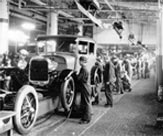U.S. Investment and Job Creation
In order to deliver on our promise of profitable growth for all, Ford is investing billions in our manufacturing facilities today so they are more efficient, flexible and even safer tomorrow. We are also investing in our workforce by securing additional jobs and in-sourcing an increasing amount of production work throughout Ford’s U.S. plants. Continuing this type of investment will depend upon our ability to sustain flexible and competitive operations in all of the markets where we do business. To do this, we must have competitive labor rates and competitive work practices.
At this moment, one of the most important items on our country’s agenda is job creation. Ford is committed to adding jobs in its U.S. facilities as is practicable. A new Entry Level Wage Structure,negotiated in partnership with the UAW, has helped us achieve a more competitive total labor rate and therefore has allowed us to create jobs across the country to meet customer demand as our market share improves.
We’ve also been In-Sourcing, or bringing jobs back into our plants that had been previously sourced through outside suppliers. In fact, Ford has committed to in-source over 1,500 jobs from 2008 through 2012, and we’re on track to exceed that number by several hundred jobs. In-sourcing is more cost-effective for many reasons: It can help us offset certain currency risks associated with out-sourcing to other markets. It allows us to keep commodities needed in production closer to the plant, which minimizes inventory levels and lowers freight costs. And in-sourcing helps us to better control quality because the manufacturing of these parts benefits directly from our robust quality processes and testing.
- Ford’s recent U.S. investments include $550 million to transform the company’s Michigan Assembly Plant.
- Ford invested $870 million for three plants involved in the F-Series Super Duty and Mustang launches.
- Ford is investing $600 million to transform Louisville Assembly, and $400 million for Kansas City Assembly.
- Ford plans to invest $850 million in the state of Michigan to produce fuel-efficient products and components in multiple plants.
- Ford’s production of the new Explorer in Chicago has led to the addition of 1,200 direct jobs, plus 600 supplier jobs.
- Ford will add more than 7,000 new hourly and salaried jobs between 2011-2012 in the U.S.
- Ford made a commitment to its workers to bring more than 1,500 jobs back in to U.S. plants through in-sourcing, and then exceeded that commitment by 35 percent.
- Ford’s labor cost gap with the transplant automakers was $27 an hour in 2007. Today it stands at $8.
Central to all these job creation efforts is our need to get the business equation right first. We are succeeding here, especially with our new blended labor rates, but there’s still work to be done. Ford’s Labor Cost Gap with the transplant automakers was $27 an hour in 2007. Today it stands at $8. This gap has given our competitors an advantage in profitability for years. And while it’s shrinking, the gap still exists. For Ford to remain competitive, we’ll need to close that gap even more.
In-sourcing and job creation are part of Ford’s broader program of Investing in the U.S. today so our manufacturing facilities are more efficient, safe and flexible tomorrow. Investment is critical if Ford is to continue to produce high-quality vehicles and compete globally. The progress we have made so far is proof that U.S. manufacturing can thrive. At Ford, we’re confident that we can continue to demonstrate that the U.S. is a good place to maintain a strong manufacturing presence.
Ford’s goal is clear: profitable growth for all, over the long term. Achieving this goal is essential to continued job creation and job security across the U.S. — and to the vitality of thousands of communities in which our plants, our parts warehouses and our dealers are based. Ford has a significant direct and indirect economic impact on the communities in which we operate, including the vast auto supplier industry and thousands of indirect jobs we support.
Ford’s competitiveness and job security are tied together. We can and will create more jobs if we can produce the products people really want and value, and do so in a way that’s more efficient and cost-effective than the competition. When Ford succeeds, all our stakeholders succeed — and as Ford stays competitive and reliably profitable, we will continue to create jobs more broadly across the country.













